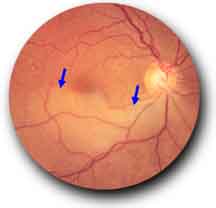Eye Care > Diseases of the Eye > Artery Occlusion

In this photograph, the affected area of the retina is the pale, whitish-yellow region (blue arrow) that is normally supplied by the blocked artery. The surrounding reddish-orange area is healthy retina tissue.
• Transient loss of vision prior to the artery occlusion (in some cases).
Central artery occlusion
• Sudden, painless and complete loss of vision in one eye.
Branch artery occlusion
• Sudden, painless, partial loss of vision in one eye.
Artery occlusion is diagnosed by examining the retina with an ophthalmoscope.
Unfortunately, there is no treatment that can consistently restore vision lost from an artery occlusion. However, if it is caught within the first hour and treatment is initiated immediately, recovery is possible in rare cases.
The following conditions increase the risk of problems that may affect the vessels of the eye:
Illustrations by Mark Erickson
With acknowledgement to St. Lukes Eye Hospital.
| Cookie | Duration | Description |
|---|---|---|
| cookielawinfo-checkbox-analytics | 11 months | This cookie is set by GDPR Cookie Consent plugin. The cookie is used to store the user consent for the cookies in the category "Analytics". |
| cookielawinfo-checkbox-functional | 11 months | The cookie is set by GDPR cookie consent to record the user consent for the cookies in the category "Functional". |
| cookielawinfo-checkbox-necessary | 11 months | This cookie is set by GDPR Cookie Consent plugin. The cookies is used to store the user consent for the cookies in the category "Necessary". |
| cookielawinfo-checkbox-others | 11 months | This cookie is set by GDPR Cookie Consent plugin. The cookie is used to store the user consent for the cookies in the category "Other. |
| cookielawinfo-checkbox-performance | 11 months | This cookie is set by GDPR Cookie Consent plugin. The cookie is used to store the user consent for the cookies in the category "Performance". |
| viewed_cookie_policy | 11 months | The cookie is set by the GDPR Cookie Consent plugin and is used to store whether or not user has consented to the use of cookies. It does not store any personal data. |